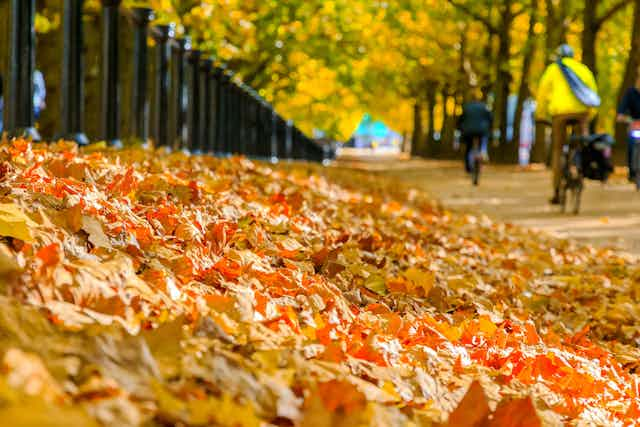Towards the end of autumn the days get colder and shorter. This triggers the reduction of the plant hormone auxin in most deciduous trees, which start to shed their leaves.
In natural woodlands, this isn’t an issue. Fallen leaves gather on the ground and eventually decompose, recycling their nutrients back into the soil to support plant growth the following year. All part of a natural cycle.
But things are different in streets or other parts of urban areas. There, leaf litter can block road gullies, drains and gutters leading to localised flooding. During wet conditions leaves are slippery and can make walking on pavements unsafe.
Leaves blown onto railway tracks need to be cleared without delay as wet leaves can quickly turn into mulch reducing the friction between rail and wheel. Piles of dried leaves on land can be a fire hazard.
And when leaves deposit on still water they can reduce sunlight levels for aquatic plants and animals, eventually turning the water smelly and lifeless
Autumn leaves around the world
We work in the UK, where local authorities tend to collect fallen leaves and send them to be disposed of either at composting plants or incinerated to produce electricity or heat. This is what happens to most leaves in other countries too, though there are some alternate options.

For instance a municipality in the Netherlands has been promoting leaving the leaves to decompose as it could improve soil health and wildlife. A study in Germany recommends using autumn tree leaves as a feedstock to produce biogas, a form of renewable energy.
Meanwhile, researchers in Finland have found that natural pigments present in the autumn leaves can be used in cosmetics, textiles and food industries. And in Japan, some fallen leaves are collected for use in arts and crafts.
How we should manage fallen leaves
Many plant and soil scientists say that autumn leaves should be left to break down naturally, as they provide food, shelter and nesting materials for birds, mammals and invertebrates. In private gardens, this may be the most sustainable and ecologically beneficial option.
But leaving leaves everywhere isn’t for everyone. Other options include turning them into compost, by adding small quantities layer by layer to home composting systems, or shredding them and turning them into compost-like leaf mould or mulch (which differs from compost as it’s broken down by fungi instead of bacteria).

While burning leaves is likely to cause particulate air pollution, burning garden waste is still permissible in the UK, providing the smoke does not cause a nuisance to neighbours or affect any motorways. Residents can also dispose of fallen leaves from gardens at their nearest household waste recycling centres, to be included as a feedstock to industrial composting facilities, to produce a nutrient rich soil enhancer.
Some local authorities in the UK offer a garden waste collection service, where residents pay an annual subscription fee for regular collections of their garden waste.
Street leaves don’t make good compost
Street leaf litter requires different treatment. A report published by the UK’s Environment Agency found that compost produced from street leaf litter sweepings contained significantly higher concentrations of polycyclic aromatic hydrocarbons (PAHs) than in green and food waste composts.
PAHs are byproducts of incomplete combustion of fossil fuels and petroleum products such as petrol and diesel used in private and public transport. They are persistent pollutants which may cause cancer.
The same report also found that compost produced may not be suitable for agricultural and horticultural use due to contaminants including grit, plastics, metals, glass, rubber, animal faeces, salt and pollution associated with vehicle emissions.
This means street leaf waste should not be turned into compost. Instead it is diverted to waste-to-energy recovery facilities which burn the leaves to generate combined heat and power.
Depending on where they fall, autumn leaves can be a valuable resource. They can be managed biologically to produce useful organic byproducts, such as compost, leaf mould and mulch. However, due to the risk of contamination, street leaf litter sweepings should be used to produce energy rather than sent to landfills.

Don’t have time to read about climate change as much as you’d like?
Get a weekly roundup in your inbox instead. Every Wednesday, The Conversation’s environment editor writes Imagine, a short email that goes a little deeper into just one climate issue. Join the 20,000+ readers who’ve subscribed so far.

